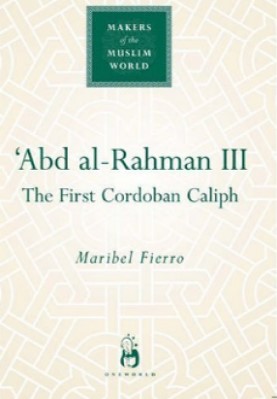
| Abd Al Rahman Iii |
| Maribel Fierro |
| 161 |
| |
| PDF Direct Download Link |
| Click for Hard Copy from Amazon |
ABD AL-RAHMAN III – book Sample
THE FOURTEEN DAYS OF HAPPINESS OF ‘ABD AL-RAHMAN III (r. 912–61)‘
dynasty in al-Andalus unprecedented strength inside and influence abroad during the first half of the tenth century (he reigned from 912 to 961), was said to have kept a daily written record of his forty-nine years’ reign. It revealed, after his death, that he had had only fourteen days of happiness.
He did not say which ones they were. Were those days connected with the most successful campaigns against his foes, on which we have so much information? Was one of them the day he received the oath of allegiance as ruler without meeting any opposition from the rest of his family, in spite of his youth?
Or the day he returned victorious to Cordoba after the first military expedition he commanded in person? Or the day when Bobastro, the fortress where his enemies the Hafsunids had managed to resist for years, was conquered? Or the day he proclaimed himself caliph, the title borne by his Umayyad ancestors when they ruled the Islamic world from Damascus?
Or the days the rebellious towns of Toledo and Zaragoza were finally overcome? Or the day the magnificent hall he built in Madinat al-Zahra’, the town he had founded near Cordoba, was finished? Were those days of happiness connected with his private life, about which we know so little?
Whichever they were, the point of the anecdote is that those days were but few for a man who enjoyed power, authority, wealth, military success, beautiful women, and many children. Were they few because his personality or character precluded him from enjoying life?
Were they few because most of his life was spent under the pressure of continuous fighting in order first to maintain the unstable rule he had inherited, then to expand and consolidate it? Or were they few because the responsibility of a ruler, a caliph, was such that happiness, both regarding this life and the other, necessarily became a rarity?
The anecdote, in fact, might just belong to the repertoire of things that are said about rulers and that make the stuff of ancient moral tales and modern soap operas.
A hugely success- ful soap opera that was shown with equal success in Mexico and post-Soviet Russia had the telling title “The rich also cry,” and many in their deprivation took comfort from this.
An anecdote telling that a caliph only had fourteen days of happiness was intended to teach that happiness is not dependent on the things one owns, but on the way one lives one’s life. Consequently, the poor man and the rich man have equal opportunities of achieving happiness.
Such an anecdote could have been told about any other powerful man. The fact that ‘Abd al-Rahman III is the protagonist is an indication that he had acquired literary and symbolic dimensions.
And this was also helped by the fact that his triumph was closely connected with fall.‘Abd al-Rahman III’s pacification of al-Andalus, his consolidation of Umayyad rule, and his relationships with such powerful political and religious figures as the Byzantine emperor, the Fatimid caliph of North Africa, and the German emperor, were all achievements destined to be of short duration.
Some fifty years after his death, the caliphate he had established was crumbling, never to recover, and Madinat al-Zahra’ was lying in ruins. The fourteen days of happiness might also stand for the brevity of ‘Abd al-Rahman III’s success. And yet al-Andalus had been changed by him forever.
Among the changes brought by the first Umayyad caliph in the Islamic west, and developed under his successors, a not unimportant one was the impulse given to the emergence of a dis- tinct identity for al-Andalus.
But what exactly was al-Andalus?
AL-ANDALUS BEFORE THE SECOND UMAYYAD CALIPHATE (EIGHTH–NINTH CENTURIES) -WHAT WAS AL-ANDALUS?
Al-Andalus was the name given by Muslims to the Iberian peninsula, and in a more restricted sense, the name given to the territory under Muslim rule.
That territory was not always the same.
Until the eleventh century, most of the Iberian peninsula was controlled by Muslims, except for the northern regions, where small Christian kingdoms emerged.
That the core of Muslim settlement and rule lay in the south is indicated by the location chosen for the capital of al-Andalus.
The Visigoths, the former Germanic rulers of the Iberian peninsula, who had entered from the north, had established their political and religious capital in Toledo, situated roughly in the middle of the peninsula.
Toledo fell into Muslim hands when Muslim armies conquered the Iberian peninsula in the second decade of the eighth century and it had a crucial role in frontier politics,
To read more about the Abd Al Rahman Iii book Click the download button below to get it for free
Report broken link
Support this Website
for websites